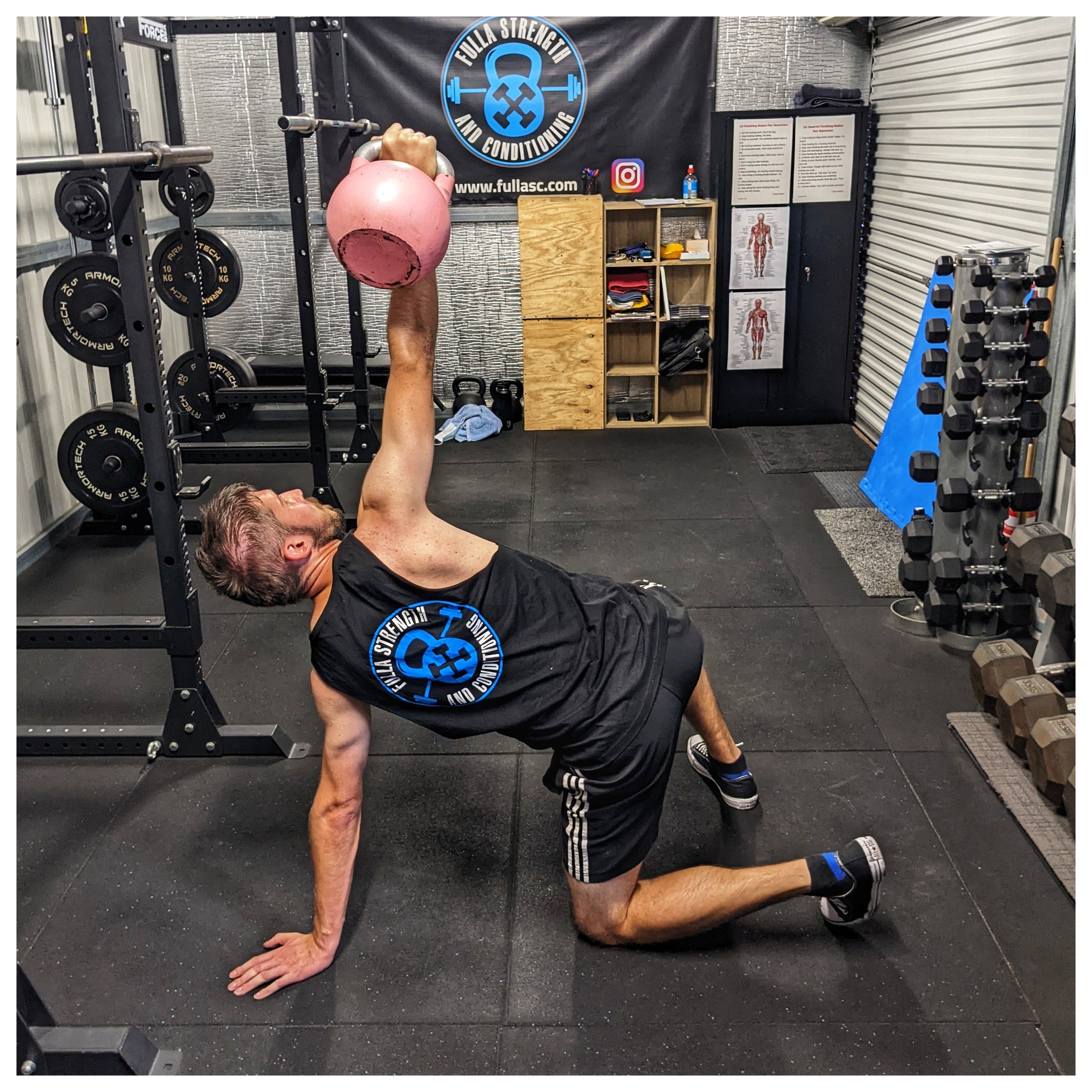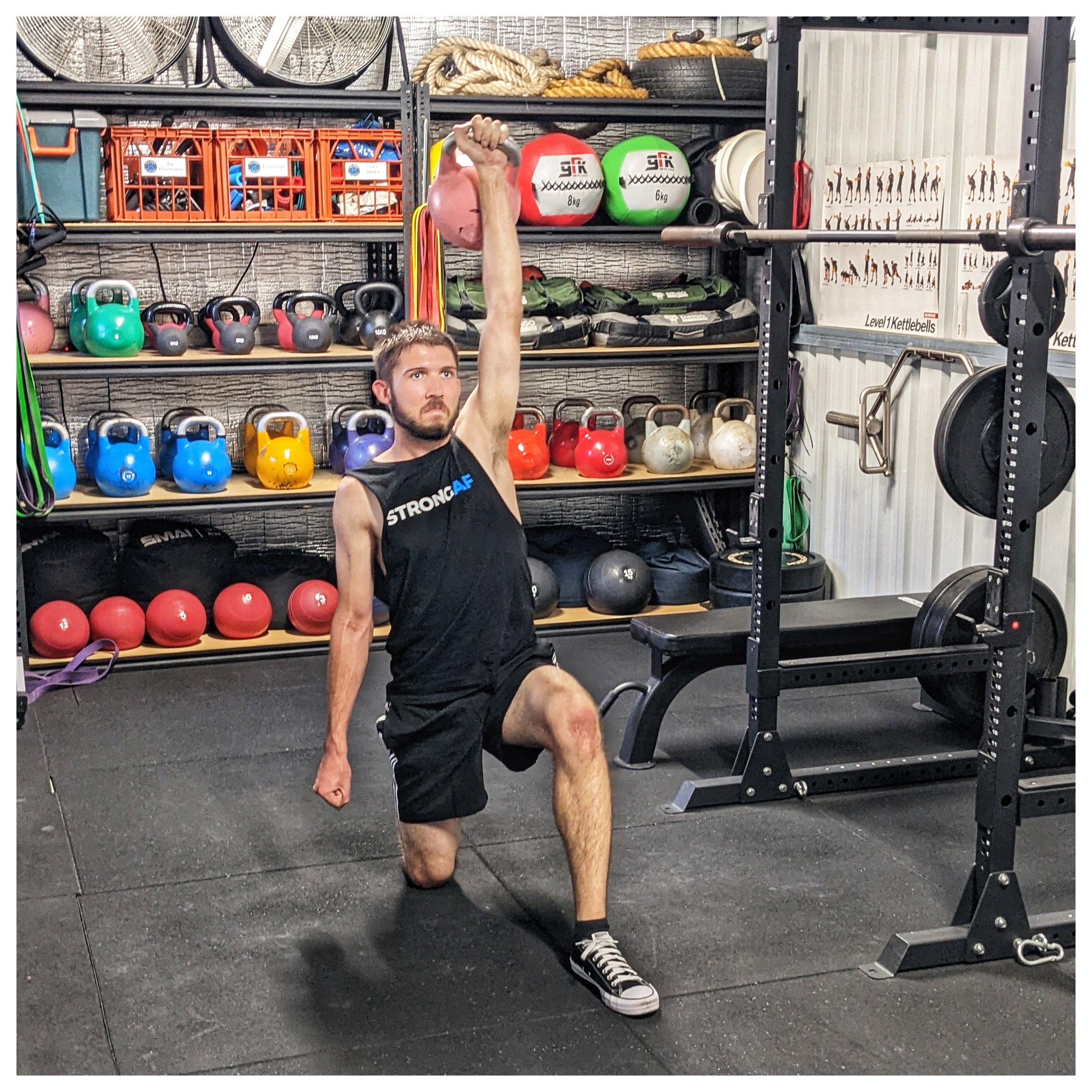Turkish Get-Ups For Total Body Strength
There aren’t many strength exercises that require the whole body to work in concert quite like The Get-Up.
It places huge demands on the shoulder muscles, triceps, upper back, and midsection muscles as soon as you pick the kettlebell up and press it into position.
From the word ‘GO’, you must concentrate on what part of the exercise you’re at, and what comes next.
If you aren’t paying attention to what you’re doing, the kettlebell will give you some instant, brutal, feedback about what needs addressing.
This Is One Of The Things I Love Most About The Get-up — It Has An Inbuilt Feedback System.
It’s a bit like a “bullshit detector” in that, if you haven’t mastered each step, you get feedback.
If you haven’t been practicing the movement as consistently as required, you get feedback.
When the transitions or steps are jerky and uncontrolled, again, you get that feedback.
But the turning point really comes from when you start nailing each part of the exercise. You get to a point where you know precisely where you are, and what the next step is.
And you have eliminated all the unnecessary bouncy parts and got rid of those little unwanted micro-movements (such as elbow bending-straightening).
Don’t let this exercise fool you. Even though you typically perform only one rep at a time, it feels like you’re doing several.
Holding a kettlebell overhead without it moving around for the better part of a minute per rep is hard work!
There is a large amount of Time Under Tension (TUT), and a single repetition can range anywhere from 30-75 seconds. This means the working muscles will achieve gains in both strength and hypertrophy.
And then there are the benefits of muscular balance and symmetry in the body due to the unilateral nature of the exercise. Loading one side of the body at a time, and then trying to mirror the exact movement, on the other side.
Typically, you will perform one rep on your non-dominant arm (the strong side) and then repeat that on your dominant arm (the stronger side).
Doing this gives you the opportunity to iron out any deficiencies or ‘gaps’ that you might have in your body. From how you spend your work/family life, the daily postures you assume, and the loads that you place upon the body.
The Get-Up can help restore movement in neglected areas, improve whole-body mobility, develop strength in the postural muscles, and increase midsection strength.
While this exercise looks cool and impressive to do (which it is!), many kettlebell users jump the gun, trying to advance quicker than their skill level allows.
This Is When Things Get Ugly, How Safety Gets Compromised, And How Injuries Occur.
There are some aspects to take into consideration before you attempt this essential kettlebell exercise.
Let’s go through them so you can learn the important steps, and get started with the Turkish Get-Up!
1. Do you have adequate joint mobility?
These are two simple tests that you can do to see if you have the required joint mobility — specifically in the shoulders & upper back — to start your journey of practicing this exercise.
You have two options at your disposal to try;
1) Supine shoulder flexion
Lay on your back, with straight legs, abdominals lightly braced, and your arms by your side, thumbs facing up.
With straight arms (no elbow bend), raise one arm up overhead so your thumb touches the floor, without drifting away from your body.
If you can do this, see if you can do it with a closed fist.
This must be done with no change in your lower back — no arching of the lumbar spine.
In this position, your bicep should be close to your ear or touching.
Repeat on the other side.
2) Standing shoulder flexion
Stand up tall with your feet under your hips, abdominals braced, glutes squeezed, and your arms by your side, thumbs facing forward.
Lift one arm up towards the ceiling as high as possible while keeping your arm completely straight.
It should be vertical or near-vertical. From a side view it should look like this;
There should be a straight line from your ankle to your wrist overhead.
With no excessive arching of the lower back, and a neutral head posture.
Repeat on the other side.
If you CAN’T do this on both arms, you need to work on your shoulder and thoracic mobility.
If you CAN do this on both sides successfully, you may proceed to the first version of the exercise.
2. Can you do the unloaded version?
Before you go and grab a loaded kettlebell, you must know the movement and all its different steps through the bodyweight get-up.
It is not a simple exercise to learn, let alone master!
The Get-Up has a steep learning curve, especially if you care about getting the most out of each rep.
I’ve analysed lots of reps online and I teach the movement in person, in Perth. And frankly, I see too many people who “do get-ups” that probably shouldn’t be using a kettlebell.
I understand the appeal of this all-in-one powerhouse of an exercise. Truly, I do.
Having the ability to do it shows huge amounts of strength, good joint mobility, and a willingness to be patient in the process to nail each part of it.
This is why your first step in learning the movement is, to begin with, your own bodyweight.
Most people have a tendency to go straight for the weight they think they can handle (and oftentimes more).
This is a mistake!
I’m all for you challenging yourself and training hard. But I want to be sure that your technique is solid and you have a strong foundation for us to place a load on top of it.
Below is the bodyweight version of the exercise, The Naked Get-Up.
Start here, and then progress only once you can nail each and every step on both sides of your body.
Note: The Movement Should Look The Same On The Left And The Right.
3. Do you have what it takes to pass the “grading” — The Shoe Get-Up?
Before any of my students progress to a kettlebell, they must first pass what I call “grading”, the unloaded version.
As in martial arts, you only graduate to the next belt or receive your next stripe, if you can show that you meet the required standards.
Now, you’ve just learned, practiced, and hopefully, completed the bodyweight version (The Naked Get-Up).
This is the first box to tick off when learning the get-up and progressing to the real thing.
Next, We Introduce A Very Light Load: A Shoe.
The reason a shoe is used is that it mimics the movement, can be performed safely with minimal risk, and only a small deviation is required for you to lose the shoe.
Low risk, high reward — which is very good from a skill acquisition standpoint.
It highlights any movement flaws, jerky motions, and uncontrolled aspects of the movement.
If you fail to do it with a shoe, you do not pass my grading system, and won’t be allowed to use a kettlebell.
You must earn the right to perform the Kettlebell Turkish Get-Up. You don’t simply get to try it out because it looks cool, or you want to be able to post it on your social media platforms.
I care more about your ability to safely and proficiently perform this complex movement than boosting your ego.
If You Fail The Grading, You’re Not Ready For It…Yet.
It means you must spend more time “chopping wood”, practicing the steps, and refining your skills.
You can look at this one of two ways;
Use it as a chance to learn, grow and develop the movement to the required standard (growth mindset).
Believe I am being overly pedantic of your technique. Or think I’m picking on you, and the exercise ‘sucks’ (fixed mindset).
Ultimately, it comes down to your perspective and how you want to respond to the facts.
If your technique isn’t up to scratch, it needs to be improved. Simple as that!
But I would like you to think about it through this lens.
If you can’t execute the movement to the required standard and you ignore this, it will only amplify your errors when you use a kettlebell.
Sometimes Going Back One Or Two Steps Is A Blessing In Disguise.
Doing this allows you to bring up your weak points to the level that they become your strengths and are no longer the limiting factor for you.
As humbling as this can be for the ego, it provides you with the necessary teaching moments required to learn all the intricacies of the movement.
The best way to learn the movement isn’t by reading about it or watching videos — it’s by doing it.
This means putting in the work and practicing the movement one rep at a time.
Learning from your mistakes and what part of the movement can be improved or optimised.
Because there is ALWAYS something you can do to make it better.
This is the pinnacle of kettlebell training! Trying to get more out of less.
You don’t have to do five or ten different exercises to work your entire body. The Turkish Get-Up covers it all when done correctly.
It works your shoulders, triceps, lats, stomach, obliques, abs, legs, and grip, all in one.
Although it has numerous steps and requires your commitment to regular practice, it can replace a host of other exercises.
The Get-Up is a skill, and like any skill, it must be practiced regularly to get the best results out of it.
“Kettlebell Training Is An Inch Wide But A Mile Deep”.
What does this mean?
You might have to break the exercise down into small parts and work on them individually before you put it back together collectively.
Break it apart, polish it, refine it and then rebuild it back into one coherent movement.
You can always improve something — whether it be your overall technique, increased joint mobility, better muscular control, or more endurance.
Whatever your goal is, I guarantee that having (and using) improved technique will assist you in getting there.
Nobody ever complained about the fact that their technique was “too good”.
But using the incorrect technique...well, that can cost you a whole lot more — time, effort, frustration, results, little niggles, and even big injuries.
Remember: your technique is always the most important thing!
I hope this information gives you a platform to start learning this amazing movement and then enjoy the journey of diving deep into the complexities of it.
The further you go and the more you practice, the more you will get out of every rep.




